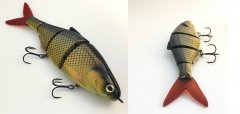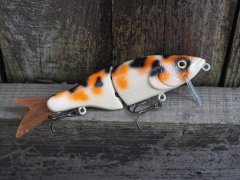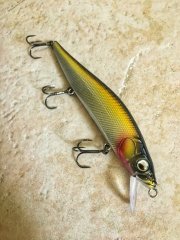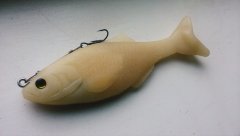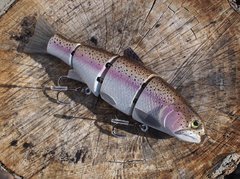-
Posts
211 -
Joined
-
Last visited
-
Days Won
2
Content Type
Profiles
Articles
TU Classifieds
Glossary
Website Links
Forums
Gallery
Store
Everything posted by porkmeatballs
-

Krylon Spray Paint Reacting with Platinum Cure Silicone?
porkmeatballs replied to porkmeatballs's topic in Hard Baits
That would make sense, but I also don't want to muddle too much of the details on the master with epoxy... I have heard that some specific types of spray on clears get along nicely with platinum cure silicone, but I would have to do a bit more digging to figure out which ones. -

Krylon Spray Paint Reacting with Platinum Cure Silicone?
porkmeatballs replied to porkmeatballs's topic in Hard Baits
Yes I actually did use a hairdryer to help accelerate the outgassing process and then waited a few more weeks just to be safe. And just to clarify, this was for a master that I made a mold with, not a fishable bait. -

Krylon Spray Paint Reacting with Platinum Cure Silicone?
porkmeatballs replied to porkmeatballs's topic in Hard Baits
Update: I waited a few weeks for the Krylon to outgas and attempted another mold. It seems like it turned out pretty well! I guess I was a bit too hasty at first and should have let the Krylon fully cure first. Now I know haha -

Krylon Spray Paint Reacting with Platinum Cure Silicone?
porkmeatballs replied to porkmeatballs's topic in Hard Baits
I believe the Smooth-On 29NV is a tin cure silicone, correct? I have also used tin cure silicone for a while and have had zero issues with this particular Krylon spray paint. I only began to run into problems when I switched to this new platinum cure silicone. I think that platinum cure is much more sensitive and can be inhibited by a wider range of substances/materials... -

Krylon Spray Paint Reacting with Platinum Cure Silicone?
porkmeatballs replied to porkmeatballs's topic in Hard Baits
I'm currently trying to wait for any other fumes to outgas from the master and will try placing a small amount of silicone on top to see if I still have problems. If that fails I will definitely try to clear coat it with something before trying again. Thanks for the input! -
Hello everyone! It's been a while since I posted on this site, but I recently ran into a problem when trying to mold a bait. I recently carved a new lure and then primed it using a gloss Krylon spray paint. It looked great and I had high hopes as I went to mold it using platinum cure silicone. I waited 12+ hours for the silicone to cure just to be safe, but when I opened the mold the entire surface of the master hadn't seemed to cure. The rest of the mold had cured perfectly, but the surface of the bait had a thick coat of uncured silicone on it. Any ideas on what caused this? One of my ideas is that the Krylon hadn't completely outgassed prior to me pouring the silicone, which then led to cure inhibition. The rest of the mold/surfaces cured perfectly, it was just the surface of the bait that had problems. If it is a problem with the Krylon spray paint, how long does it take to completely outgas? I have successfully used the same paint to cover previous baits, but I didn't mold them until quite a bit after they were coated. Any thoughts would be appreciated before I waste even more time and silicone
-

7 1/2" Stalker Shad
porkmeatballs commented on porkmeatballs's gallery image in Best Homemade Hardbait
-
This is a 4-piece resin swimbait with a soft plastisol tail. The bait has a smooth, kicking action on steady retrieves and can also be ripped/twitched to get a more erratic action. I painted this particular bait in a golden shiner colorway by layering a number of different paints as well as utilizing a mesh material for the scale detailing.
-
I do wait about a day or so before painting over the primer. I also don't actually get the "bubbles" until after I try scratching the clear coated baits. After scratching, the createx just seems to pull off. Perhaps I will have to try using the hairdryer to get rid of the solvents. I'm just bummed that I have to figure out how to scrape off these nice paint jobs and start all over again
-
Hmm that could be the reason. However, I haven't used gloves in the past and have never had issues like this before. I recently picked up some rustoleum paint/primer which I used for the first time on these particular baits. All the rest of the painting is done using createx paints.
-
Yes I also use a hair dryer between layers of paint. I also allow the paint to dry for about a day in my garage where it is pretty dry. These lures are all resin, so there isn't the problem of moisture inside the baits. I was also thinking that the paint is having trouble binding to the paint primer. When I try scratching the lure with my fingernail, sometimes I can get what looks like a bubble under the paint. It kind of looks like the paint and clear formed a shell that has parted from the primer.
-
Well it's been quite a while since I posted this thread! I actually pulled the trigger on some Spray Max 2k clear and used it on a small batch of lures. Unfortunately I ran into quite the problem. The finish looked spectacular and was rock hard, but after a brief session in the water large sections of paint started to peel completely off a few of the baits. The paint primer that I used stayed on, but all the createx that I laid on top of it fell off with the clear coat. Has anyone else experienced this problem? There are a few factors that I believe may have caused this issue: 1) I allowed the painted baits (not cleared yet) to air dry in the same proximity to where I pour soft plastic lures. 2) I clear coated the lures outside where the air was somewhat smoky 3) I wasn't wearing gloves during the painting process Not sure if any of these factors would cause the clear to peel off, but any insight or suggestions would be greatly appreciated!
-
Yes yes, here's yet another clear coat thread! I came across the aerosol Spray Max 1k clear coat on Amazon and was wondering if any of you have had any experience with this product. I have heard lots of great things about the Spray Max 2k clear, but disliked the fact that the whole can must be used shortly after being activated. How's the durability and shine of the Spray Max 1k? https://www.amazon.com/Spray-max-Aerosol-Clearcoat-3680058/dp/B00B3I2DN0/ref=sr_1_1?crid=2XL8O6LN4RLWQ&dchild=1&keywords=1k+clear+coat&qid=1587943795&sprefix=1k+clear%2Caps%2C214&sr=8-1
-
-

Golden Shiner Jerkbait
porkmeatballs commented on porkmeatballs's gallery image in Best Custom Painted Hardbait
-
-
This Bone colored Shima Shad is a soft plastic swimbait that is hand poured using plastisol. It features a wedge-like tail that enables the bait to kick at most speeds. In order to keep the bait running true, there is an internal harness that is constructed out of resin. The swimbait is rigged with a treble hook that is secured to the line tie using saltwater grade wire leader.
-

Bravo Tackleunderground.JPG
porkmeatballs commented on porkmeatballs's gallery image in Best Homemade Hardbait
-
The 7" Bravo Trout is made to mimic a small trout as it swims through the water. This bait is hand poured, hand painted, and features a soft plastisol tail that helps to increase the bait's realism as it moves through the water. This Bravo has a special, one-off paint job that includes a brown back and metallic purple lateral lines and gills.
-
Do you guys know if it's fine to use alumidust in the urethane to give it color?
-
Hmmm I will be pouring fins, so these batches will most likely be pretty small... However, I do have syringes that are pretty accurate.
-
Yeah, I guess I'll try mixing by volume. I think their website does say to mix by weight, but I really don't want to have to buy a scale unless it's necessary.
-
Alright guys, I've got another question for you. I just got some Alumilite Flex 70 (urethane) to make fins for my resin swimbaits. Can I mix the two parts by volume, or do I have to do it all by weight? I've never used the stuff, so any pointers would be greatly appreciated. Thanks!
-
Haha maybe it's just me!
-
Ah I see. Other glide baits have this problem as well, then? It just seems kind of annoying when the bait keeps going to the same side.




